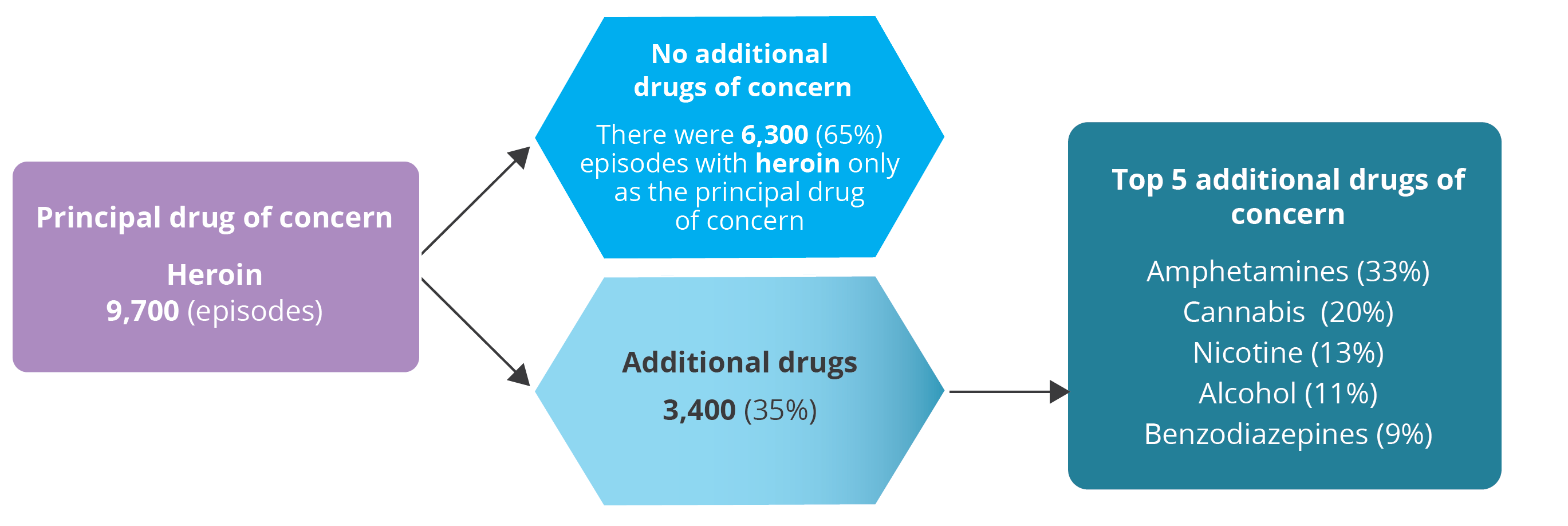Heroin: client demographics and treatment
On this page:
In 2022–23, heroin was reported as a drug of concern (either principal or additional) in 5.7% of all treatment episodes (12,367 episodes) (Table Drg.4).
Heroin was the fourth most common principal drug of concern:
- In 4.5% of all treatment episodes (9,745 episodes) (Table Drg.4).
- This has remained consistent across the 10 years to 2022–23, although the proportion of heroin-related episodes has declined from a peak of 7.0% (12,000 episodes) in 2013–14 (Table Drg.5).
In 2022–23, over 1 in 3 (35% or 3,424 episodes) heroin-related treatment episodes reported at least 1 additional drug of concern (Table Drg.2). The most common additional drugs of concern were amphetamines (33% or 1,863 episodes), cannabis (20% or 1,134 episodes) and nicotine (13% or 753 episodes) (Table Drg.3). Clients can nominate up to 5 additional drugs of concern: these drugs may not have been the subject of any treatment within the episode.
Figure HEROIN: Closed treatment episodes for own alcohol or drug use by heroin as a principal drug of concern and additional drugs of concern, 2022–23

Note: Diagram presents the top 5 additional drugs of concern for a principal drug of concern. Totals do not add to 100%.
Treatment for heroin use in the AODTS NMDS collection
People who receive treatment for heroin use have several options for treatment, including withdrawal programs (called detoxification) and abstinence-based treatment (for example, residential rehabilitation in a therapeutic community) (O’Brien 2004).
In Australia, one of the most common treatments for heroin use is opioid pharmacotherapy treatment (also known as opioid agonist therapy). Opioid pharmacotherapy involves replacing opioid drugs, including heroin, with a longer-lasting, medically prescribed opioid.
Agencies whose sole function is to prescribe or provide dosing services for opioid pharmacotherapy are excluded from the AODTS NMDS. Data from these agencies are captured in the National Opioid Pharmacotherapy Statistics Annual Data (NOPSAD) collection (AIHW 2024). For more information, please see the 2023 NOPSAD report.
For information on heroin use and harms, please see:
Client demographics
In 2022–23, 5,573 clients received treatment for heroin as the principal drug of concern. Of these clients:
- Over 2 in 3 were male (67% of clients) (Table SC.9).
- Almost 2 in 3 were aged either 30–39 (32% of clients) or 40–49 (33%) (Table SC.10). This was consistent for both males and females (Figure HEROIN 1).
- Over 1 in 5 were Aboriginal and Torres Strait Islander (First Nations) people (21% of clients) (Table SC.11). This represents a crude rate of 195 First Nations clients per 100,000 people (Table SCR.26).
Figure HEROIN 1: Clients with heroin as the principal drug of concern, by sex and age group, 2022–23
The butterfly bar chart shows that in 2022–23, male clients receiving treatment for heroin as the principal drug of concern were most likely to be aged 40-49 (33.9%) followed by 30-39 (30.9%). Female clients were most likely to be aged 30-39 (34.2%) followed by 40-49 (31.3%).

Treatment
In 2022–23, 9,745 treatment episodes were provided to clients for heroin as the principal drug of concern (Table Drg.4).
Among heroin-related treatment episodes in 2022–23:
- Self/family (42% of episodes) was the most common source of referral into treatment followed by health services (28%) (Figure HEROIN 2, Table Drg.55).
- The most common main treatment type was assessment only (23% of episodes), followed by pharmacotherapy (19%) and counselling (18%) (Figure HEROIN 2, Table Drg.54).
In the 10 years to 2022–23, main treatment types for heroin have fluctuated:
- Treatment episodes for withdrawal management decreased from 18% to 7.8% (or from around 2,141 to 762 episodes).
- Conversely, pharmacotherapy episodes increased from 10% to 19% (or from around 1,230 to 1,807 episodes). Fluctuations in pharmacotherapy treatment episodes over time can be attributed to changes to jurisdictional coding practices and systems, resulting in under-reporting of pharmacotherapy at the national level (Table Drg.54).
- Over 7 in 10 treatment episodes took place in a non-residential treatment facility (71% of episodes) (Table Drg.56).
- The median duration of treatment episodes was around 5 weeks (34 days) (Table Drg.58).
- About 3 in 5 treatment episodes ended with a planned completion (58% of episodes), while 1 in 5 (20%) ended unexpectedly (Figure HEROIN 2, Table Drg.56).
Figure HEROIN 2: Treatment episodes with heroin as the principal drug of concern, by main treatment type, reason for cessation or source of referral, 2013–14 to 2022–23
The line graph shows that counselling has been the most common main treatment type among treatment episodes for cannabis for most of the 10 years to 2022–23. The number of counselling episodes has fallen from 4,169 in 2013–14 to 1,725 in 2022–23. Other treatment types fluctuated across time, with assessment only becoming the most common treatment type in 2022–23 (2,244 episodes). Filters allow the user to view data as the number or per cent of episodes for main treatment type, reason for cessation or source of referral.

In 2022–23, injecting remained the most common method of use in heroin-related treatment episodes (72% of episodes) (Table Drg.6). Clients reported injecting drugs in the past 3 months in nearly half of treatment episodes (47% of episodes). In a further 11% of episodes, clients reported that they last injected 3–12 months ago (Table Drg.52).
Between 2013–14 and 2022–23 the proportion of treatment episodes where clients receiving treatment for heroin as a principal drug of concern reported that they had never injected drugs increased almost 4-fold, rising from 5.4% (648 episodes) to 19% (1,867 episodes) (Table Drg.52).
AIHW (2024) National Opioid Pharmacotherapy Statistics Annual Data collection, AIHW, Australian Government, accessed 30 May 2024.
O’Brien S 2004. Treatment options for heroin and other opioid dependence: a guide for families and carers. Canberra: Department of Health and Ageing.


